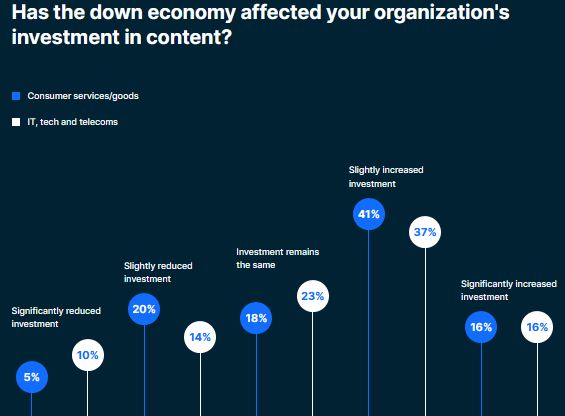Whether you’re a seasoned blogger or you’re just starting out, keeping your audience engaged can be incredibly challenging.
Consistently coming up with fresh ideas can be draining, and even with the best of intentions, blogs can sometimes fall flat, leaving your readers disengaged or worse, clicking away from your website without giving it a second glance.
Moreover, with so many voices competing for attention, standing out requires more than just good writing – it demands creativity, strategy, and a deep understanding of your audience.
Still, even with all these challenges, companies continue to invest in content marketing strategies, like blogging, and that’s because they work.
For example, the results of a recent Bynder survey are very telling.
The vast majority of marketers who responded to this survey, which polled more than 1,200 marketing professionals, have a strategic interest in content marketing, with 86% of CMOs saying they plan to either maintain or increase their investments in it.
What’s more, as you can see from the graph below, even with the economic downturn we’re seeing today, most marketers surveyed said that as a result of these economic conditions, their organizations have actually increased their investments in content.

But of course, if you want to see results from your blogging efforts, you’ve got to understand how to write an engaging blog, and what makes a good blog post.
Even if you think of yourself as a writer, blogging is a very different animal, which requires some special know-how.
With that in mind, I want to offer some tips on blogging to help you give your audience what it wants by consistently creating great content.
So, if you’re wondering how to keep your audience engaged, and want to know how to write better blog posts, keep reading to learn more.
Read: How the Benefits of Blogging Can Seriously Help Your Website and Boost Your Business in 2024

If you’re looking for tips on blogging, chances are you’re well aware of how it can benefit your business.
But maybe you haven’t taken the time to explore this, or you need a reminder of why it’s so important.
Whatever the case, this article explores the benefits of blogging, including better SEO, more website traffic and leads, improved relationships with customers, and more.
8 Tips on Blogging to Keep Your Audience Engaged
Whether you consider yourself a writer or not, if you have a website for your business, you should be blogging.
But trying to consistently come up with content that will keep your audience engaged can feel like a losing battle.
With that in mind, below I’ve offered several tips on blogging, so you can make your blogs more engaging and entice people to come back to your website and read more.
1) Update Your Blog Frequently
I know it sounds harsh, but if you’re not going to update your blog frequently, you’re probably just wasting your time.
But why is that?
Well, there are two reasons to add new posts to your blog on a frequent and consistent basis.
The first one being that if someone visits your blog and sees that the last article posted was six months ago or more, then their immediate impression might be that you’re no longer in business, or at least no longer maintaining your website, which is always a bad look.
Believe it or not, people’s reaction can be that drastic!
Most people won’t assume that you’re too busy to tend to your blog, but what they will assume is that you’ve abandoned your website, and therefore your business.
In my experience, most people tend to believe that how you do one thing is how you do everything, so if you’re publishing blogs haphazardly, putting out poorly written content, or not even blogging at all, that will reflect on your business whether you want it to or not.
Plus, if you’re not regularly publishing content, and staying top of mind with your audience, eventually, they’re going to forget about your blog and move on to the next thing.
The other reason to frequently update your blog is for Search Engine Optimization (SEO) purposes.
Because the more you write and post successful blog articles, the more Google and other search engines will see that you’re actively updating your website, and they tend to reward fresh content and websites that stay updated with higher search rankings, which makes it easier for people to find your website.
Now, if you want to stay consistent, you should make a posting schedule and stick to it!
But how often should you post?
Let me put it this way: Once a month is better than every six months, once a week is better than once a month, and multiple times per week is better than once a week.
You get the idea.
2) Provide Quality Over Quantity
As important as it is to post frequently, and regularly, if the content you’re posting isn’t any good, it’s not going to matter when you post it.
Having said that, you should post as much as you possibly can, but the content you post has to be excellent.
The key word here is quality. You want your blog posts to be engaging and valuable to the reader. This isn’t a space to wax poetic or list what you had for dinner last night.
This is your space to showcase your expertise and explain what your offerings can do for potential customers.
So, if you want your blogging efforts to be successful, you’ve got to write about topics that your target audience wants to learn about, and that’s why understanding your audience and knowing who your ideal clients are is critical.
You want to write about things that potential and existing customers will find interesting, valuable, informative, entertaining, and/or captivating.
You should write for your target audience, not for yourself, and not for the sake of having something posted, or to create glorified sales pitches for your products.
In doing so, when you’re writing something, you should always ask yourself what you want your readers to get out of it and what you want them to do or know after they’ve read it.
3) Try to Focus on One Topic Per Post
I get it. You’re passionate about your business, and when you sit down to write, you want to share every thought that comes into your head.
That being said, it’s great that you’re so passionate. And it’s great that you have so many ideas.
But you shouldn’t try to squeeze them all into one post.
In fact, it’s much better to stick to one topic or point for each blog you publish.
For one thing, it’ll help Google understand what your post is about, which makes it easier to connect with the right audience, as they’ll be looking for articles on that topic.
But it’s also easier to keep people engaged and hold their attention when you stick to one topic.
Plus, if the title of your article implies that it’s about one thing, but the reader finds out it’s a meandering mess of disparate topics, you’re going to annoy them, and at that point, they’re probably not going to return to your blog.
This might turn out to be harder than you’d think, and if you’re anything like me, that one specific topic will make you want to explain everything related to it and the next thing you know, you’re going down a massive rabbit hole.
But luckily, you can save all those ideas and rabbit holes as ideas for new blogs!
4) Include Relevant Images
If you want your blog posts to be engaging, images are a must.
Not only do images help your readers get a visual idea of what your article is about, but they also help to break up the text, emphasize important points, and create something that looks more interesting than just a massive wall of text.
But make sure the images you’re using are high-quality, in focus, and relevant to what you’re writing about.
Otherwise, you’re going to confuse or annoy the reader, who’s not going to appreciate looking at pixelated, blurry images that have nothing to do with your article.
Ideally, each article should have an appealing display image (or “hero image” as we call them), which will entice people to click on it, and you should also include a couple more images throughout each article to break up the text.
Using images in your blog posts is also one of the simplest things you can do to make your website more popular – both with users and with search engines, as they both appreciate attractive websites with lots of imagery.
5) Don’t Use Third-Party Blogging Services
Whatever you do, make sure to host your blog on your own website, and avoid using third-party services like Tumblr for your business blog.
Unfortunately, because these services are free and usually easy to set up, they can be very tempting to use.
But what you’re doing when you use these services is sending people to their platforms instead of your website – and at the end of the day, bringing traffic to your website is one of the main reasons why you should be blogging!
So, don’t leave the SEO benefits of blogging on the table.
If you have a blog, it should be housed on your website, and nowhere else.
6) Fix the Spelling and Grammar Mistakes
Honestly, this shouldn’t even have to be said. But, oh my goodness, does it ever need to be said!
I remember once reading someone’s blog post and the grammar mistakes made it so hard to read that I gave up. The irony is, she was a copywriter!
Can you guess what impression her readers have on her ability to write? Probably not so great.
Even if you’re not a writer trying to sell your services, publishing blog posts that are riddled with errors is going to reflect negatively on you and your business, because it looks like you either don’t know or don’t care about this sort of thing.
Understandably, not everyone has a degree in English. I don’t either.
And if you look hard enough, you’ll find mistakes in my writing.
But that’s not the point here, nor the expectation. The goal is to write something that is very readable and not full of obvious mistakes.
So, if you’re one of those people who has great ideas and lots of information to share but you’re terrible in the English department, it might be time to hire someone to help you.
We do this a lot for our clients – they’ll send us a rough draft, and then we’ll edit it, SEO-optimize it, make it look pretty, and add it to their blog.
Easy-peasy for the non-writer.
7) Make Your Blogs Easy to Scan
When you take the time to write a great article for your blog, you want to make sure people actually stick around long enough to read the whole thing, right?
Aside from having a compelling title, beautiful imagery, and a well-written article, another way to keep your audience engaged and coming back for more is to make your blog posts easy to scan.
Like it or not, the reality is very few people read anything online word for word, so it’s critical to ensure your main message comes across, or that there’s at least an indication of the various sections of the article when someone scans it.
To do this, it’s best to break up the text with headings, subheadings, bolding, images, and bullet points. But don’t overdo it on the bullet points!
I’ve come across many people who hear that they should use bullet points in their articles and then end up writing practically the entire thing like that.
Don’t be that person!
8) Create Long-Form Content
How do you truly captivate your audience?
Typically, it’s by connecting with a fascinating story, a personal anecdote, or by impressing with your expertise.
And in all of these cases, a few hundred words probably isn’t going to cut it.
No matter what the topic is, you don’t want to drone on and on, but as long as the level of quality remains the same, your articles will be better if they’re longer, as they’re just offering more value to the reader.
Plus, once you’ve done all that fancy formatting, readers will be able to scan your article, reading only the parts that are relevant to them, and they’re going to appreciate that.
What’s more, they’ll probably remember that, and as a result, they might come back to your blog.
And a word to the wise: when it comes to SEO, the longer the article, the better (assuming, of course, that it’s also well written and interesting).
I know. It’s a big puzzle to put together.
You have to post frequently, and you also have to post long articles, but those articles also have to be nicely formatted, well-written, and appealing to your target audience.
Phew!
Do you need help creating content that will keep your audience engaged? Why not set up a free 30-minute consultation with me to find out how we can help?
To your business success,
Susan Friesen
P.S. If you liked the article, you might want to subscribe to our newsletter. We publish tons of valuable content to help you learn more about marketing, and subscribing is the best way to ensure you don’t miss out. Additionally, if you’d like to learn more about building a search engine optimized website, click here for our free website guide.







